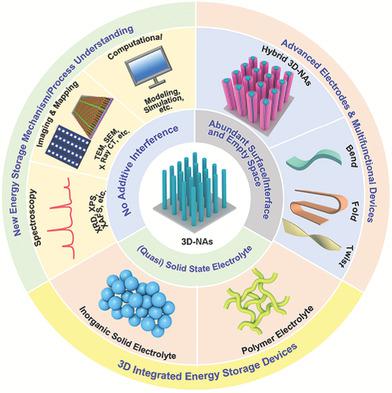当前位置:
X-MOL 学术
›
Adv. Mater.
›
论文详情
Our official English website, www.x-mol.net, welcomes your
feedback! (Note: you will need to create a separate account there.)
Surface and Interface Engineering of Nanoarrays toward Advanced Electrodes and Electrochemical Energy Storage Devices
Advanced Materials ( IF 27.4 ) Pub Date : 2021-02-22 , DOI: 10.1002/adma.202004959 Linpo Li 1, 2 , Wenyi Liu 2 , Haoyang Dong 2 , Qiuyue Gui 2 , Zuoqi Hu 1 , Yuanyuan Li 1 , Jinping Liu 2, 3
Advanced Materials ( IF 27.4 ) Pub Date : 2021-02-22 , DOI: 10.1002/adma.202004959 Linpo Li 1, 2 , Wenyi Liu 2 , Haoyang Dong 2 , Qiuyue Gui 2 , Zuoqi Hu 1 , Yuanyuan Li 1 , Jinping Liu 2, 3
Affiliation

|
The overall performance of electrochemical energy storage devices (EESDs) is intrinsically correlated with surfaces and interfaces. As a promising electrode architecture, 3D nanoarrays (3D‐NAs) possess relatively ordered, continuous, and fully exposed active surfaces of individual nanostructures, facilitating mass and electron transport within the electrode and charge transfer across interfaces and providing an ideal platform for engineering. Herein, a critical overview of the surface and interface engineering of 3D‐NAs, from electrode and interface designs to device integration, is presented. The general merits of 3D‐NAs and surface/interface engineering principles of 3D‐NA hybrid electrodes are highlighted. The focus is on the use of 3D‐NAs as a superior platform to regulate the interface nature and unveiling new mechanism/materials without the interference of binders. The engineering and utilization of the surface of 3D‐NAs to develop flexible/solid‐state EESDs with 3D integrated electrode/electrolyte interfaces, or 3D triphase interfaces involving other active species, which are characteristic of (quasi‐)solid‐state electrolyte infiltration into the entire device, are also considered. Finally, the challenges and future directions of surface/interface engineering of 3D‐NAs are outlined. In particular, potential strategies to obtain electrode charge balance, optimize the multiphase solid‐state interface, and attain 3D solid electrolyte infiltration are proposed.
中文翻译:

面向先进电极和电化学储能设备的纳米阵列的表面和界面工程
电化学能量存储设备(EESD)的整体性能与表面和界面本质上相关。作为有前途的电极体系结构,3D纳米阵列(3D-NA)具有相对有序,连续且完全裸露的单个纳米结构的活性表面,有助于电极内的质量和电子传输以及跨界面的电荷转移,并提供了理想的工程平台。本文介绍了3D-NA的表面和界面工程的关键概述,从电极和界面设计到设备集成。强调了3D-NA的一般优点以及3D-NA混合电极的表面/界面工程原理。重点是使用3D-NA作为高级平台来调节界面性质,并在不受粘合剂干扰的情况下推出新的机制/材料。3D-NA表面的工程设计和利用,以开发具有3D集成电极/电解质界面或涉及其他活性物质的3D三相界面的柔性/固态EESD,这是(准)固态电解质渗透到其中的特征整个设备,也都考虑在内。最后,概述了3D-NA的表面/界面工程的挑战和未来的方向。特别是,提出了获得电极电荷平衡,优化多相固态界面以及实现3D固体电解质渗透的潜在策略。3D-NA表面的工程设计和利用,以开发具有3D集成电极/电解质界面或涉及其他活性物质的3D三相界面的柔性/固态EESD,这是(准)固态电解质渗透到其中的特征整个设备,也都考虑在内。最后,概述了3D-NA的表面/界面工程的挑战和未来的方向。特别是,提出了获得电极电荷平衡,优化多相固态界面以及实现3D固体电解质渗透的潜在策略。3D-NA表面的工程设计和利用,以开发具有3D集成电极/电解质界面或涉及其他活性物质的3D三相界面的柔性/固态EESD,这是(准)固态电解质渗透到其中的特征整个设备,也都考虑在内。最后,概述了3D-NA的表面/界面工程的挑战和未来的方向。特别是,提出了获得电极电荷平衡,优化多相固态界面以及实现3D固体电解质渗透的潜在策略。也被考虑。最后,概述了3D-NA的表面/界面工程的挑战和未来的方向。特别是,提出了获得电极电荷平衡,优化多相固态界面以及实现3D固体电解质渗透的潜在策略。也被考虑。最后,概述了3D-NA的表面/界面工程的挑战和未来的方向。特别是,提出了获得电极电荷平衡,优化多相固态界面以及实现3D固体电解质渗透的潜在策略。
更新日期:2021-04-01
中文翻译:

面向先进电极和电化学储能设备的纳米阵列的表面和界面工程
电化学能量存储设备(EESD)的整体性能与表面和界面本质上相关。作为有前途的电极体系结构,3D纳米阵列(3D-NA)具有相对有序,连续且完全裸露的单个纳米结构的活性表面,有助于电极内的质量和电子传输以及跨界面的电荷转移,并提供了理想的工程平台。本文介绍了3D-NA的表面和界面工程的关键概述,从电极和界面设计到设备集成。强调了3D-NA的一般优点以及3D-NA混合电极的表面/界面工程原理。重点是使用3D-NA作为高级平台来调节界面性质,并在不受粘合剂干扰的情况下推出新的机制/材料。3D-NA表面的工程设计和利用,以开发具有3D集成电极/电解质界面或涉及其他活性物质的3D三相界面的柔性/固态EESD,这是(准)固态电解质渗透到其中的特征整个设备,也都考虑在内。最后,概述了3D-NA的表面/界面工程的挑战和未来的方向。特别是,提出了获得电极电荷平衡,优化多相固态界面以及实现3D固体电解质渗透的潜在策略。3D-NA表面的工程设计和利用,以开发具有3D集成电极/电解质界面或涉及其他活性物质的3D三相界面的柔性/固态EESD,这是(准)固态电解质渗透到其中的特征整个设备,也都考虑在内。最后,概述了3D-NA的表面/界面工程的挑战和未来的方向。特别是,提出了获得电极电荷平衡,优化多相固态界面以及实现3D固体电解质渗透的潜在策略。3D-NA表面的工程设计和利用,以开发具有3D集成电极/电解质界面或涉及其他活性物质的3D三相界面的柔性/固态EESD,这是(准)固态电解质渗透到其中的特征整个设备,也都考虑在内。最后,概述了3D-NA的表面/界面工程的挑战和未来的方向。特别是,提出了获得电极电荷平衡,优化多相固态界面以及实现3D固体电解质渗透的潜在策略。也被考虑。最后,概述了3D-NA的表面/界面工程的挑战和未来的方向。特别是,提出了获得电极电荷平衡,优化多相固态界面以及实现3D固体电解质渗透的潜在策略。也被考虑。最后,概述了3D-NA的表面/界面工程的挑战和未来的方向。特别是,提出了获得电极电荷平衡,优化多相固态界面以及实现3D固体电解质渗透的潜在策略。











































 京公网安备 11010802027423号
京公网安备 11010802027423号